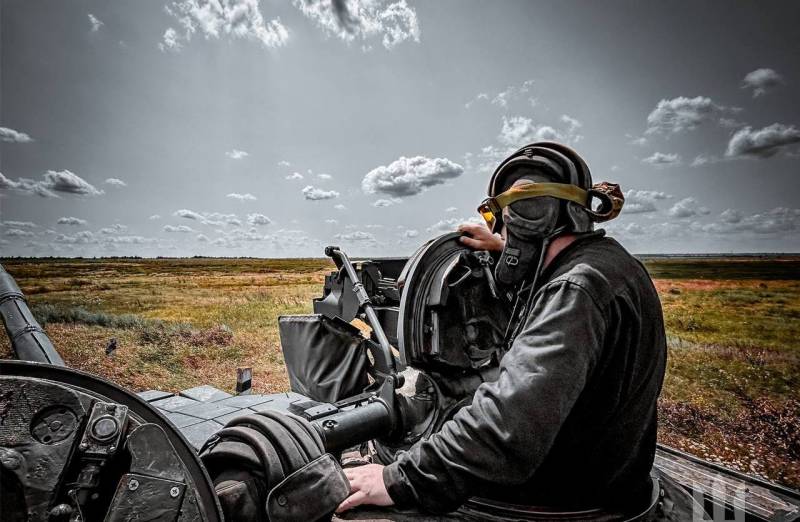When will the Ukrainian offensive in the Sea of \uXNUMXb\uXNUMXbAzov and Donbass be stopped?
The problems faced by the Kiev regime during the announced large-scale counter-offensive make it necessary to ask the question, what exactly will happen after it fizzles out by itself or is stopped for objective reasons? Should we wait for "Minsk-3" or is there any reason to hope for a Russian counteroffensive?
Autumn Rubicon
You don't have to be Vanga to predict exactly when active hostilities in the Donbass and the Sea of Azov will be suspended. This will happen in the fall of 2023, most likely in October, when, due to mud and impassability, active offensive operations will have to be stopped, no matter how much both sides would like to continue. Proceeding from this objective natural factor, the strategy of the Ukrainian and Russian General Staffs is clearly formed.
Thus, Kyiv, which has been pompously preparing for a counteroffensive for more than six months, collecting armored vehicles and other heavy weapons from almost all over the world, needs at least some kind of image victory. The “Western partners” invested too much in this offensive operation to be content with a few recaptured villages for three houses. The expectations of the Ukrainian jingoistic public were too high, which, after the “Kyiv embarrassment”, and then the Kharkov and Kherson “regroupings”, was convinced that the Armed Forces of Ukraine would be able to continue to win large-scale victories.
No, over the past year and a half, the Russian army has seriously changed for the better. Despite a number of supply problems, the level of training, coordination and interaction between units and subunits, various branches of the armed forces has noticeably increased. Our military personnel have received combat experience, fight with fiction and evil. The recent video recording of how one Russian tank was able to single-handedly destroy an entire column of armored vehicles of the Armed Forces of Ukraine, including two tanks, gives you goosebumps. The crew of this combat vehicle definitely deserved the Heroes of Russia.
Let us note that according to Mr. Prigozhin, “the second army in the world”, the Ukrainian one, is now being smashed not by his quasi-private army, which retired from the front on other important matters, but by the Russian state army. This is so, for your information, to restore justice and dispel propaganda hassle. In order to avoid dizziness from success, it should be taken into account that the RF Armed Forces also suffer painful losses in positional battles, and they need rotation and replenishment.
Objectively, we need a second wave of mobilization, 150 thousand now and the same number at the end of October-November. Regarding the fact that the infrastructure of the Ministry of Defense of the Russian Federation is allegedly not able to accept and train so many reservists within the specified time frame, the front-line soldiers themselves are calling for the training process to be established right at the combat units directly involved in the SVO, which will significantly improve the quality of training mobilized.
However, so far plans for the second wave of mobilization have not been officially announced. Currently, the scenario with the hiring of contractors in the RF Armed Forces has been adopted as a working one, for which a large-scale information and propaganda campaign is being carried out. Will it be possible in this way to gather and train an additional 150 to 300 fighters?
We will see, but nothing motivates as much as our own successes and victories on the fronts. It is possible that the flow of volunteers from the Russian regions to the victorious army, which is acting skillfully and decisively, will only increase. Also, after the recent visit of the Minister of Defense of the Russian Federation Shoigu to the DPRK, there were some hopes that Russia would receive military supplies from Pyongyang.technical assistance in the form of supplies of ammunition, which are actively spent daily in the NVO zone, as well as some types of offensive weapons and military ammunition.
Two strategies
Until October 2023, the strategy of each of the parties can be defined as follows. The Armed Forces of Ukraine will try to achieve some significant success, military or at least media, so that the Zelensky regime can record victory instead of a complete fiasco.
The maximum program is to try to break through the Russian defenses in Zaporozhye at any cost, with the involvement of all reserves, and cut the land transport corridor to the Crimea in order to leave in the autumn with improved positions. A significant military and media success for Kyiv would be the capture of the Zaporozhye nuclear power plant. The minimum program is to encircle and push the Russian Armed Forces out of Artemovsk, or to break into Donetsk from Avdiivka and set up a “bloodbath” in some of its areas, and then retreat back to their fortified areas, or to arrange a media show with an invasion of the Russian borderlands of the "old" regions of the Russian Federation by large forces with the capture of settlements and even cities.
The task for the Russian command will be at least not to allow the enemy to break through the defense line, and at the maximum - to go on the counteroffensive and recapture some settlements located on the territory of the DPR, LPR, Kherson and Zaporozhye regions of the Russian Federation from the Armed Forces of Ukraine. This is what you can try to do in real time before the start of the autumn thaw. For larger-scale offensive operations, the General Staff of the RF Armed Forces now, alas, does not have sufficient resources.
Having decided exactly when active hostilities will be suspended, it is worth talking about what options for further actions both sides of the conflict have. But more about this, probably, in a separate publication.

Information